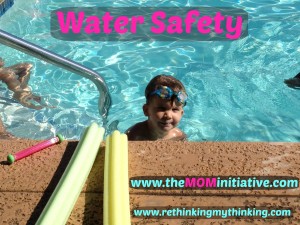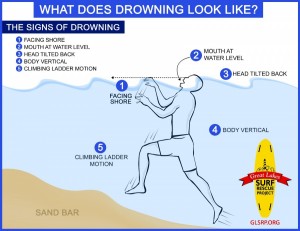It is nearly Summer. School is out and temperatures are beginning to soar.
That can only mean that swimming pools, lakes, creeks, and oceans are calling our name.
Most of us think we know what drowning looks like. We’ve seen it on T.V. or in a movie. Right?
Someone is wildly flailing their arms and crying for help. That is how we know someone is in trouble.
According to Dr. Frank Pia – over 20 years experience as a life guard – there is an instinctive drowning response that looks less like the movies and more like someone treading water. What are the signs of Instinctive Drowning Response?
- “Except in rare circumstances, drowning people are physiologically unable to call out for help. The respiratory system was designed for breathing. Speech is the secondary or overlaid function. Breathing must be fulfilled before speech occurs.
- Drowning people’s mouths alternately sink below and reappear above the surface of the water. The mouths of drowning people are not above the surface of the water long enough for them to exhale, inhale, and call out for help. When the drowning people’s mouths are above the surface, they exhale and inhale quickly as their mouths start to sink below the surface of the water.
- Drowning people cannot wave for help. Nature instinctively forces them to extend their arms laterally and press down on the water’s surface. Pressing down on the surface of the water permits drowning people to leverage their bodies so they can lift their mouths out of the water to breathe.
- Throughout the Instinctive Drowning Response, drowning people cannot voluntarily control their arm movements. Physiologically, drowning people who are struggling on the surface of the water cannot stop drowning and perform voluntary movements such as waving for help, moving toward a rescuer, or reaching out for a piece of rescue equipment.
- From beginning to end of the Instinctive Drowning Response people’s bodies remain upright in the water, with no evidence of a supporting kick. Unless rescued by a trained lifeguard, these drowning people can only struggle on the surface of the water from 20 to 60 seconds before submersion occurs.”
Now that you know how to spot someone in trouble in the water. You need to know about what some are calling “secondary drowning” or “dry drowning.”
Any distress in the water can lead to inhalation of chemical laden pool water or bacteria laden ocean/lake/creek/river water. Chemicals and bacteria can cause the tissue in the lungs to swell making breathing difficult. Inhalation of even small amounts of water can also cause spasms of the airways making breathing very difficult.
However these breathing problems can be delayed as few as 1 hour to 24 hours after leaving the water. It is important then to note the symptoms of secondary or dry drowning.
- Difficulty breathing or shortness of breath
- Chest pain
- Extreme fatigue
- Some children have had loss of bowel or bladder control
- Persistant coughing
- Change of mood
- Fever
Want to check out a few more water safety tips? Click here. Or check out the YouTube video below.
Have a FUN and SAFE Summer!
____________________________________________________
CLICK BELOW TO HEAR MORE ABOUT BETTER TOGETHER!
SEATING IS LIMITED!!! REGISTER NOW for the
2014 M.O.M. Conference ~ BETTER TOGETHER
July 31st – August 2nd,
Jacksonville, Florida at Trinity Baptist Church
Registration Information, Location, List of Breakout Sessions, Descriptions of Workshops, Conference Speaking Team, Better Together Conference Flyer, Better Together Bulletin Insert (Full Color), Better Together Bulletin Insert (Black & White), Better Together Conference Cards (Postcard Size
- Ch…ch…ch…CHANGES Are Coming in 2017 for TMI - December 27, 2016
- What New Thing Are You Ready to See God Do in Your Life in 2017? - December 26, 2016
- Heaviness and Newness - December 23, 2016





